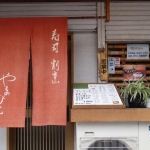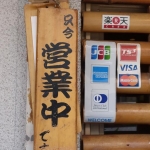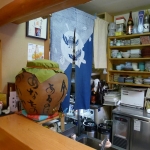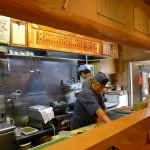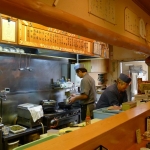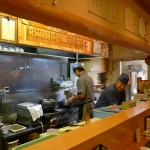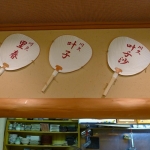Sushi
Originally, sushi was a form of preserving fish, introduced to Japan in the 8th century from Southeast Asia; this involved wrapping a piece of gutted fish in fermented rice. This allowed for fish to be stored for several months, but surprisingly, the rice was thrown away. Later, the preserved fish was eaten with rice, Japan’s staple food, and was called nare-zushi, which can still be found today.
Haya-zushi, or “quick sushi,” was invented during the early 19th century by Hanaya Yohei (there is a Japanese chain restaurant named after him), and this is the form of sushi that is known worldwide today, now called nigiri-zushi. Fresh fish from Edo Bay (present day Tokyo) was eaten with vinegared rice, and sushi yatai (food stalls) emerged all over Tokyo. It has been theorized that this form of sushi became popular throughout Japan due to the 1923 Kanto Earthquake, which resulted in the Tokyo sushi chefs evacuating back to their hometowns and spreading the sushi culture there.
Sushi can be prepared with either brown or white rice. It is often prepared with raw seafood, but some common varieties of sushi use cooked ingredients or are vegetarian. Raw fish (or occasionally other meat) sliced and served without rice is called “sashimi”. Sushi is often served with pickled ginger (gari), wasabi, and soy sauce. Popular garnishes are often made using daikon.
Sushi masters, or taisho, take great pride in their work, treating sushi-making almost like an art after decades of training; thus, it’s essential to know the different manners involved in eating sushi and making the most out of the delicious experience.
See advice for eating in sushsi-ya below.
Yamabiko
I had a wonderful and reasonable meal here just across the street from the Ebisu Shrine on Yamato Oji Dori. I felt as if I had wandered into a place filled with locals. They were kind and welcoming, even if they did not speak English. They also describe themselves as a Kappo restaurant. However, there is no clear definition of Kappo cuisine.
It does include a traditional Japanese meal brought in courses and Buddhist vegetarian cuisine. Kappo is an all-embracing word for a traditional Japanese prix-fixe menu.
In most cases, you can enjoy sliced raw fish and shellfish, deep fried fish and vegetables, fish and vegetables boiled with soy sauce, baked fish and vegetables. Using seasonal and fresh ingredients distinguishes Kappo cuisine.
A special feature of a Kappo restaurant is that you can watch the chef cooking right in front of you.
Nanezushi
At Nanaezushi, most nights you can still grab a seat at the counter without a reservation and expect to eat sushi that is both deeply satisfying and reasonably priced. The nigiri sushi comes served on a geta, reminiscent of the old-school sandal of the same name, and prices range from ¥300-¥900 for servings of any specific item.
Close by, almost in smelling distance to Nanaezushi is Kyoto’s fish market, a smaller equivalent of Tokyo’s Tsukiji, but bustling nonetheless. The chef Uemura gets all his fish from Yamasada, a famous fish wholesaler that supplies most of the top restaurants in Kyoto and is located across the road from Nanaezushi.
Higashiiru, Kitagawa, Gozen, Shichijodori, Shimogyo-ku, Kyoto; 075-312-9208; nearest station: Tambaguchi; open 5 p.m.-11 p.m. (L.O. 10 p.m.); closed Wed.; nigiri sushi from ¥300; no smoking; Japanese menu; Japanese spoken
Nakaichi
Nakaichi, located in the Gion area, is one of the better sushi places that provides simple and affordable sushi. The sushi is served in ‘kappo’ style, sushi on one plate. You can expect to see the chef preparing your sushi for you while you wait. Interact with him and you may request different parts of fish to be prepared for your sushi. Nakaichi insists on using freshly and naturally caught fish every day to provide a high standard of authentic sushi. It’s keeping the old values alive that makes this sushi spot truly a cut above the rest.
Reservations required.
Address: 570-196 Gionmachi Minamigawa, Higashiyama Ward, Kyoto, Kyoto Prefecture, Japan Phone: +81 75-531-2778
Tomizushi
When looking for the best sushi in town, diners seek out the place that uses the freshest ingredients, has the most authentic style and the most professionally trained chefs. Tomizushi ticks all three boxes. In a warm and friendly atmosphere, the chef at Tomizushi puts his every effort into both making sushi and chatting with customers. Cooking and eating here are fast paced, so get ready to dive straight in.
Address: Shijō agaru, Nakano-chō 578-5, Kyoto Phone: +81 75-231-3628
Sushisei
Sushisei is one of the best moderately priced sushi restaurants in Kyoto. They’re relatively comfortable with foreigners and its right downtown.
http://www.sushisei.co.jp/
Den Shichi
One of the best and most approachable sushi bars in Kyoto, Den Shichi serves mouth-watering sushi in a classic sushi-bar atmosphere.It is one of the best and most accessible sushi restaurants in the city. There are better sushi bars in Kyoto, but many of these are almost off-limits to foreigners (not because of discrimination – simply because you need an introduction to a regular client to get in).
Ganko Sushi
Ganko is a large sushi place offering a wide selection of sushi and other Japanese cuisines. While Ganko excels in choosing fresh and raw fish and shrimp as their primary ingredients, it also places much emphasis on balancing the freshness of the fish and the richness of the rice in the sushi. Its freshly smashed wasabi adds a punchy layer of taste to the sushi. The restaurant also aims to provide an environment and atmosphere in accordance to the style and characteristics of the sushi which is elegant and fine.
http://www.gankofood.co.jp/en/
Mametora
“Mame-zushi” are small and round size sushi for Maiko so that they can eat easily. It is located in Gion where many maiko and geiko work, you may have a chance to encounter them.There is an English menu and there are several staff who speak English, so please feel free to ask any question. Reservations are required.
http://kiwa-group.co.jp/restaurant/196/
Totoza
This is a kaiten-zushi or train restaurant and better than many counter seat style restaurants.
Eating in a Kaiten-zushi
They are most known for their conveyor-belts, which carry plates of sushi to you around the restaurant. That being said, if you want fresher fish or you can’t find what you want on the conveyor-belt, you can always ask one of the masters behind the counter to make one for you. Some places have touch-screen systems for ordering.
They are geared more towards families; not only is the sight of sushi plates arriving to you on a conveyor-belt exciting for children and adults alike, but prices are much reasonable, although not nearly as high quality (but still very good).
A plate of sushi (usually two of one kind) usually costs from around 100 yen (such as egg) to 600 yen (such as fatty tuna and sea urchin). Thus, you could easily stuff yourself with sushi and not pay more than 1000 or 2000 yen. Kaiten-zushi is a great form of fast food – not only affordable, but also healthy.
Sushi at kaiten-zushi often comes in pairs, as opposed to at formal sushi restaurants, which may come in ones or twos.
Tea is usually self-served, though they may provide the first cup for you. At most kaiten-zushi, cups and green tea powder can be found at the table, as well as a faucet for hot water.
Keep your finished plates at the table – that is how the waiter or waitress calculates how much to charge. The dishes are color- or design-coded according to their prices.
Don’t take a plate from the conveyor-belt and then put it back, even if you haven’t touched the sushi.
Kaiten-zushi restaurants also tend to have more innovative and non-sushi menus compared to formal sushi restaurants; many have various side dishes and desserts, as well as strange combinations of sushi that seem suspect at first but are actually not bad at all.
They have a much more laid-back atmosphere than formal sushi restaurants, although it is still important to know the proper way to eat sushi.
One tip when eating at a kaiten-zushi place – if possible, sit so that the master is situated diagonally right from you; since almost all conveyor-belts run clockwise, that is where the sushi is freshest from the chef’s hands.
Eating in a Sushi-ya
They are very formal; while there is no dress code, eating at a sushi restaurant involves more manners than you’d think in order to not offend the master.
It is better to make a reservation before going; if you don’t speak Japanese, asking someone who does (such as the hotel concierge) may be more helpful.
Most places have a counter and tables; the master (usually one or two, along with a few understudies) does his work right in front of the customers at the counter to ensure that his ingredients are fresh. If you’re at the counter, why not enjoy a conversation with the master?
If you don’t know what to eat, state your budget to the master and then tell him “omakase de onegaishimasu,” which means leaving the selection of sushi to the master’s recommendation according to which fish are in-season.
There are usually three ways of ordering sushi at high-end restaurants – omakase (mentioned above), okimari (set menu), and okonomi (your choice). Okimari menus are usually classified as sho (pine), chiku (bamboo), and bai (plum), in descending order of price.
Sushi at formal sushi restaurants may either come in ones or twos, although you may designate your preference; if you want to try a wider variety, there is no problem in asking the master to make you one of each.
Some sushi restaurants may offer “full courses,” in which sushi may be preceded by an assortment of other dishes, such as sashimi and grilled fish.
Eating at a formal sushi restaurant can cost you as little as 2,000 yen to over 30,000 yen at the most high-end places; usually, prices are in the 5,000 to 15,000 yen range.
Many sushi restaurants are only open during the night, though some sushi restaurants offer their services during lunch; some restaurants may even offer a special lunch menu (such as a bowl of chirashi-zushi) at much more reasonable prices.
How to Eat
Sushi is usually eaten with three different types of condiments:
Soy sauce – Almost all types of sushi are eaten with soy sauce, save for a select few such as anago. Pour some soy sauce into a tiny round dish and dip your sushi there before eating, rather than pouring it directly on the sushi.
Wasabi – Most nigiri sushi also come with wasabi, or “Japanese horseradish.” This pungent green paste enhances the deliciousness of the sushi by adding a little kick to it and also reduces the risk of food poisoning.
Shoga – (also called gari), or pickled ginger. Like wasabi, it has antibacterial properties and is eaten to cleanse your palate. An added bonus: in case didn’t find out that you put too much wasabi on your sushi until it was too late, this orange-pink condiment also cancels out its tingling spiciness.
Here are some tips and manners for eating sushi (usually applied to when eating at proper sushi restaurants
Do not put on excessive amounts of perfume, as it detracts from the sushi’s delicate taste.
Contrary to popular belief, sushi can be eaten either by using hands or chopsticks – both are perfectly fine, except for sashimi – only chopsticks are used.
Drenching the rice in soy sauce kills the taste of the sushi. In order to ensure this doesn’t happen, for nigiri-zushi, take the sushi, flip it over and dip roughly one-third or one-half of the fish in the soy sauce.
For gunkan-maki and maki-zushi, putting soy sauce on the rice is inevitable – just make sure not to put too much on it; just a tiny dab should be fine.
For gunkan-maki, one fancy and foolproof way to apply soy sauce is to dip the pickled ginger into the soy sauce, then use that as a “brush” of sorts. If the gunkan-maki comes with sliced cucumber, dip those into the soy sauce (instead of the entire thing) before eating.
It has generally been said that sushi tastes better when eaten rice-up, although this is according to preference.
Although there is no correct order of eating sushi, it is generally recommended to start off with subtly-flavored fish (usually white-fleshed, such as flounder or snapper) before moving on to more strong-flavored ones, such as tuna and sea urchin. That being said, you should enjoy sushi your own way.
Have some shoga or tea in between pieces of sushi to cleanse your palate and refresh your mouth; like shoga, tea also serves as an antibacterial. This practice originates back to when nigiri-zushi was first introduced; shoga, wasabi, and tea were crucial in a time where preservation methods of raw fish were not as developed.
Eat the sushi in one bite, in order to enjoy the harmonious taste of the rice and the ingredient. If you can’t manage it, ask the master for less rice. Do not eat the fish and rice separately (except for chirashi-zushi).
Although there is no need to rush, it is best that the sushi be eaten as soon as it is served, especially for those with seaweed.
If you do not like wasabi, be sure to tell the master beforehand – almost all pieces of sushi come with wasabi inside them as default. On the other hand, if you really like wasabi, you can always ask for more (same with shoga).
Tips are not necessary in Japan.
Types of Sushi
Sushi exists in countless variations and forms, with each region specializing in different fish and styles of cooking. Below are some of the basic types of sushi:
Nigiri-zushi – The most common type of sushi; involves a slice of raw fish or other topping on top of an oblong mound of rice. Also known as Edo-mae sushi
Gunkan-maki – The same as a nigiri-zushi but with a piece of seaweed wrapped around it. Sea urchin and salmon roe are often in gunkan-maki form
Maki-zushi – A sushi roll; raw fish and other ingredients wrapped in rice and seaweed and often eaten by hand. They come in different sizes, such as futo-maki (thick roll), and hoso-maki (thin roll)
Temaki-zushi – The same as a maki-zushi but has a conical shape and is hand-eaten.
Chirashi-zushi – Pieces of raw fish placed on top of a bowl of rice; recommended for those wanting to try a variety of fish or a lot of one kind at a cheap price. Literally “scattered sushi”
Inari-zushi – Vinegared rice inside a pouch of flavored fried tofu
Nare-zushi – A traditional form of fermented sushi
Oshi-zushi – Cured fish and rice pressed into a box or other mold; popular in Osaka and the Kansai region. Literally “pressed sushi”
Sashimi – Slices of raw fish (no rice)


